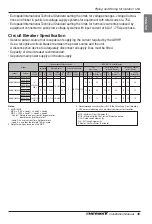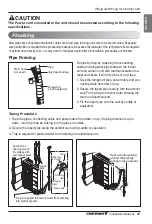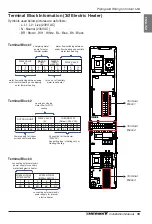
Piping and Wiring for Indoor Unit
General Consideration
Followings are should be considered before beginning indoor unit wiring.
• Field-supplied electrical components such as power switches, circuit breakers, wires, terminal
boxes, etc should be properly chosen with compliance with national electrical legislation or regu-
lation.
• Make it sure that supplied electricity is enough to operate the product including outdoor unit,
electric heater, water tank heater, etc. The capacity of fuse also selected according to the power
consumption.
• The main electricity supply should be dedicated line. Sharing main electricity supply with other
devices such as washing machine or vacuum cleaner is not permitted.
• Before starting wiring job, the main electricity supply should be turned off until wiring is com-
pleted.
• When adjusting or changing wiring, the main electricity supply should be turned off and ground
wire should be connected securely.
• Installation place should be free from the attack of wild animal. For example, mice’s wire attacking
or frog’s entering into the indoor unit may cause critical electrical accident.
• All power connections should be protected from dew condensation by thermal insulation.
• All electrical wiring should comply with national or local electrical legislation or regulation.
• The ground should be connected exactly. Do not earth the product to the copper pipe, steel fence
at the veranda, city water outlet pipe, or any other conductivity materials.
• Fix all cable using cord clamp tightly. (When cable is not fixed with cord clamp, use additionally
supplied cable ties.)
CAUTION
Hole A, B : for AC line (wire which is connected to the terminal block of the control box)
Hole C : for DC line (wire which is connected to the PCB of the control box)
Electrical Wiring
A
B
C
Installation Manual
53
ENGLISH
Summary of Contents for Therma V AHUW096A2
Page 97: ......
















































